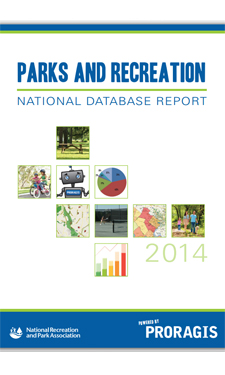 (Editor's Note: The below text is an introduction to the 2014 Parks and Recreation National Database Report, which provides in-depth analysis on the findings of PRORAGIS over the past three years. The report relies heavily on charts, graphs, and visuals, which can be found in the original document. Please reference the complete document, linked above, for full understanding.)
(Editor's Note: The below text is an introduction to the 2014 Parks and Recreation National Database Report, which provides in-depth analysis on the findings of PRORAGIS over the past three years. The report relies heavily on charts, graphs, and visuals, which can be found in the original document. Please reference the complete document, linked above, for full understanding.)
Across the country, park and recreation agencies provide people with the resources they need to build sustainable, healthy communities with opportunities for all. Offering a broad range of programs and services to support the natural environment, encourage nourishing lifestyles and level the playing field for all members of the community, park and recreation agencies often do much more than their local officials may realize. In their work, professionals in this field as well as citizen advocates help establish a strong foundation for the nation as a whole.
To help communicate this message of impact, NRPA developed the three pillars — Conservation, Health and Wellness, and Social Equity — which together showcase the ways in which park and recreation agencies help build and strengthen their communities.
But while the broader benefits of parks and recreation are generally easy to convey, it’s often much more difficult to quantify this information in ways that translate to more funding and support. PRORAGIS™, the Park and Recreation Operating Ratio and Geographic Information System developed by NRPA, is a resource to help you do just that.
Now in its fifth year, the PRORAGIS database tool has become the most comprehensive and largest collection of detailed data on municipal, county and state park systems in the U.S. With thousands of data points and more than 500 completed profiles, PRORAGIS contains reliable, detailed data on a wide range of park agency metrics, allowing agencies to compare their operations and offerings to other agencies of similar size and population as they self-evaluate. NRPA encourages park systems to update their information every year to keep data as current as possible. Each year, as participating agencies update their profiles and new agencies register, PRORAGIS becomes an ever-stronger tool that agencies can use to learn and apply insight into trends and realities of park systems across the country.
By comparing and evaluating your program offerings, operation cost per resident or direct revenue per capita, you can develop sound, fact-based arguments when asking for budget increases and other support from local or state governments. By employing the Eco-Benefit Calculator and Custom Reports functions of PRORAGIS, you can demonstrate specific, positive impacts on the environmental, public health and social equity benefits that your agency’s programs, parks and facilities bring to a community — strengthening your case.
Impacting Communities
As more agencies add their information to the PRORAGIS database, patterns begin to emerge that show trends in the ways that park and recreation agencies impact their communities. Often, these trends directly align with the pillars, clearly illustrating these key areas of influence delivered by parks and recreation and allowing agencies to measure how their programs compare to others in relation to the pillars. For example, in 2012 and 2013, health and wellness, fitness and team sports programs topped the charts as programs offered by agencies. In 2013, more agencies offered community gardens, where families were able to grow healthy foods and lessen their environmental impact. Also in 2013, more departments offered feeding programs for before-school programs than ever before.
Reading This Report
We divided responses into median (middle 50 percent), lower quartile (lowest 25 percent) and upper quartile (highest 25 percent) divisions to help you determine where your agency stands in the spectrum of responses. Although hundreds of agencies have logged data into the PRORAGIS system, each park system may not answer every question; this accounts for the fluctuating number of responses in each data set.
Learn what PRORAGIS can do for you.
PRORAGIS What's New?
Better Navigation: A completely redesigned, user-friendly interface with more intuitive organization makes for smoother navigation and easier data entry. In addition, more reliable and secure access allows agencies to control who can enter and edit data.
Updated GIS: The new layout includes two new tools (Identify and Query) to help users navigate maps and get information more quickly. The Identify feature allows users to click on a map feature to see key attributes. With the Query tool activated, users can complete in-depth searches keyed to particular conditions (e.g, “view all parks smaller than 25 acres”). Users can also measure areas and distances, search for locations, and examine topographic and street maps.
Eco-Benefit Calculator: This ever-expanding calculator helps park professionals understand the complex and intangible — yet valuable — assets that parks, land, programs and facilities offer to a community. Using mathematical algorithms, the Eco-Benefit Calculator estimates the dollar value of your park or facility in terms of health, ecology, local business revenue, tax revenue and other factors. Using this tool, park professionals can gain a clearer picture of a park or facility’s true worth to a community or region. Additional enhancements will soon include values for stormwater mitigation, aquatic environments, health and wellness, and crime reduction for teens.

